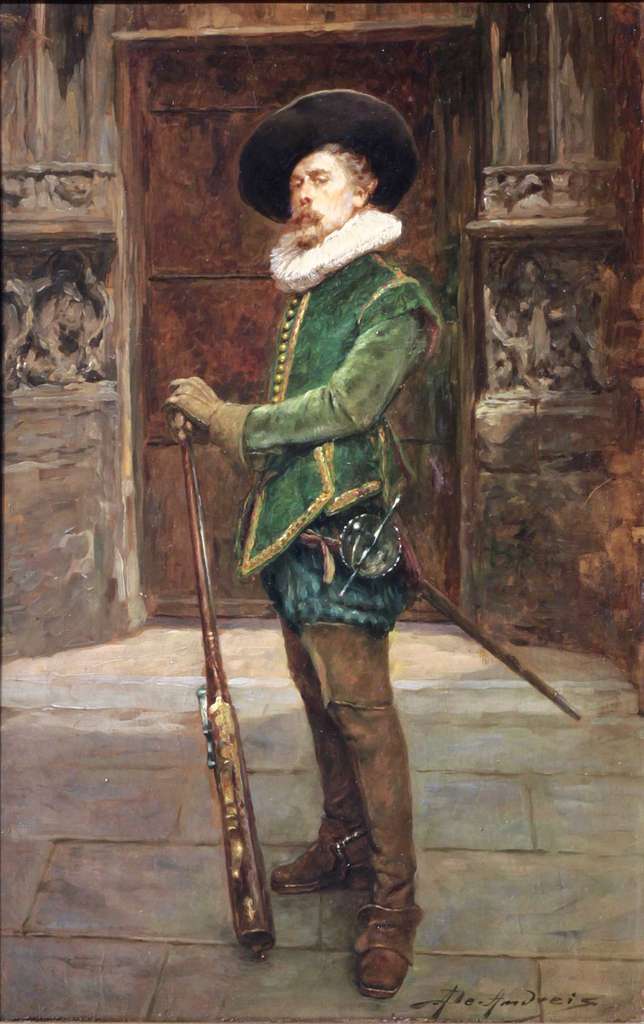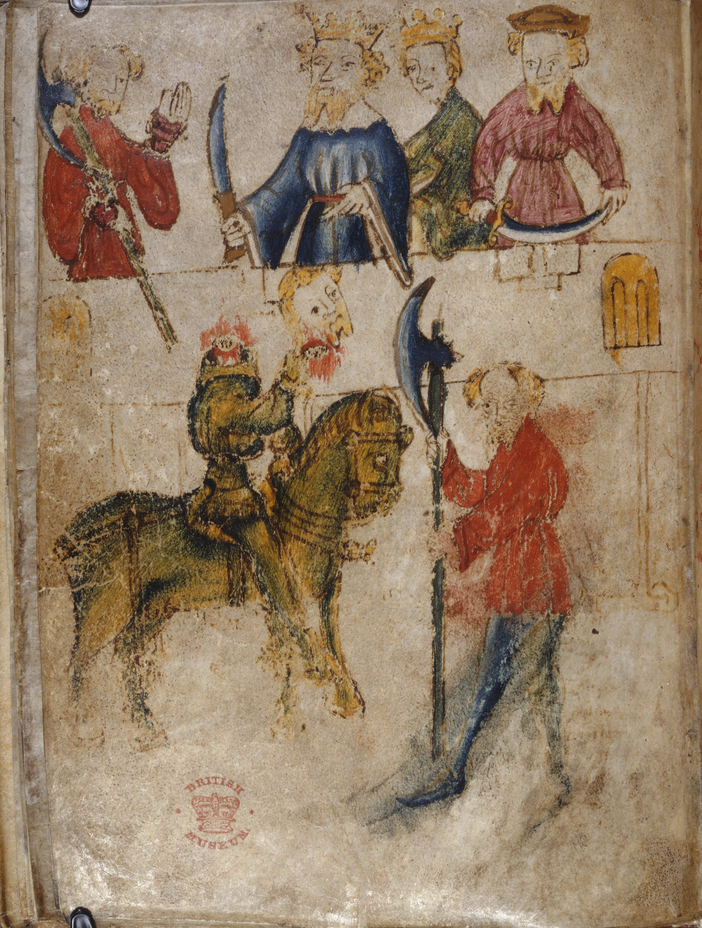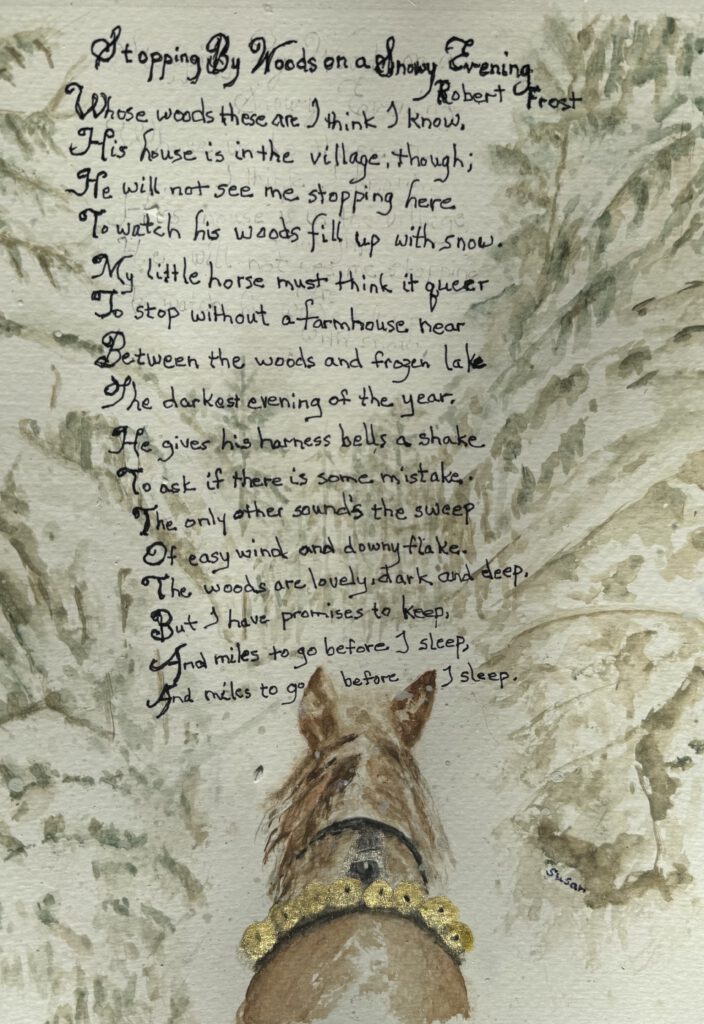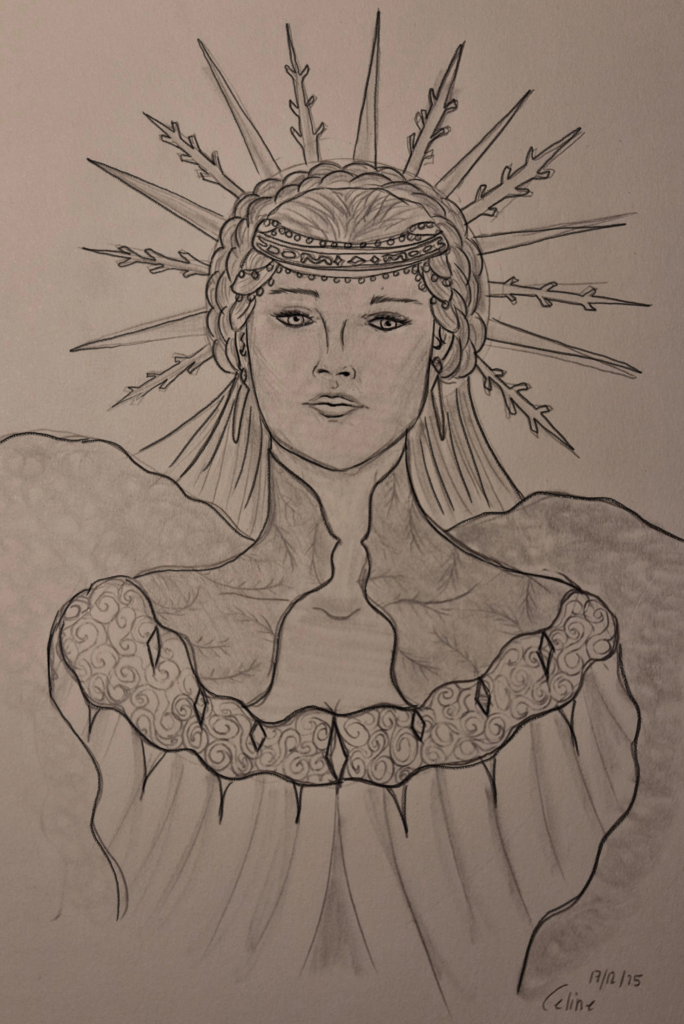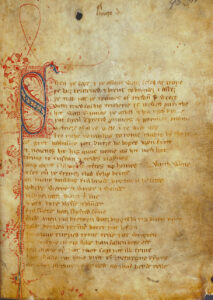Othello in the South Seas: Robert Louis Stevenson’s “The Beach of Falesá” as Shakespearean Rewriting
Lucio De Capitani
Published in Connotations Vol. 34 (2025)
Abstract
This article reads Robert Louis Stevenson’s Pacific novella “The Beach of Falesá” (1892) as a rewriting of Shakespeare’s Othello. There are, in fact, several clues that Stevenson had Othello in mind while travelling in the Pacific, and while working on “Falesá” specifically: once the two texts are compared, a set of structural parallels and thematic convergences appears. While “Falesá” is not strictly speaking an adaptation of Othello, it is, however, an early case of “writing back” to Shakespeare’s text, anticipating the work of several postcolonial and feminist authors. In a first step, I will explore which clues invite this reading to begin with, while also showing that Stevenson’s engagement with Shakespeare is connected to his interest in realism. Secondly, I am going to stress several convergences between the character relations in Othello and those in “Falesá,” detailing how Stevenson translates the character dynamics of Othello into the South Seas, initially focusing on Othello/Wiltshire and Iago/Case. Finally, I will discuss how and why Stevenson, in a few deliberate deviations from Othello, subverts Shakespeare’s tale, with a special focus on Uma and Desdemona.
Introduction
Early in his career, Robert Louis Stevenson was rather fond of unsubtle, playful nods to Shakespeare’s The Winter’s Tale. For instance, in Prince Otto (1885), the reader is told that Grünewald, where the story is set, borders Seaboard Bohemia, “celebrated for its [...] mountain bears” (4)—a reference to both Shakespeare’s geographical liberties and to the most famous animal to have graced a stage direction in the history of English theatre. Keeping up with the joke, it is also suggested that Otto “drew his descent through Perdita, the only daughter of King Florizel the First of Bohemia” (4)—most likely the daughter of Florizel and Perdita from Shakespeare’s play. Prince Florizel of Bohemia is also the protagonist/recurring character in other early works like The New Arabian Nights (1882) and The Dynamiter (1885). This overt set of references functions primarily as an intertextual divertissement: Stevenson indulges in creating a micro-genealogy for his princely characters that leads back to a literary world he is enamoured with.
The engagement with Shakespeare that this essay explores, conversely, is rather covert, but it also involves a serious critical response to Shakespeare’s work, a far cry from the facetious intertextual game discussed so far. My argument, in short, is that it makes sense to read the Pacific novella “The Beach of Falesá”1 (1892) as a rewriting of Shakespeare’s Othello. This is because there are several clues that Stevenson had Othello in mind while travelling in the Pacific, and while working on “Falesá” specifically; and because, once the two texts are compared, a set of structural parallels and thematic convergences appears. To the extent that “adaptations have an overt and defining relationship to prior texts” and “usually openly announce this relationship” (Hutcheon and O´Flynn 3), “Falesá” is not an adaptation of Othello. It does work, however, as an early case of “writing back” to Shakespeare’s text, as several postcolonial and feminist authors have done in the course of the twentieth and twenty-first centuries (see Chambers). In other words, I propose to treat “Falesá” as a subversion of the Shakespearean text. [→ page 210]
The essay is divided in three parts: firstly, I explore which clues invite this reading to begin with, while also showing that Stevenson’s engagement with Shakespeare is connected to his interest in realism. Secondly, I stress several convergences between the character relations in Othello and those in “Falesá,” detailing how Stevenson translates the character dynamics of Othello into the South Seas, initially focusing on Othello/Wiltshire and Iago/Case. Finally, I discuss how and why Stevenson, in a few deliberate deviations from Othello, subverts Shakespeare’s tale, with a special focus on Uma and Desdemona.
Realism à outrance Nothing Extenuated
In 1883, in a letter to his cousin Bob, Stevenson praises Shakespeare as “the only realist who ever succeeded” (Letters 4: 181). This is indeed high praise, since Stevenson, at the time, would not have called himself a realist. At that stage of his career, Stevenson embraced a conception of fiction, largely coinciding with romance, that eschewed a social and psychological focus, and was looking “not for eloquence or character or thought, but for some quality of the brute incident” (“A Gossip on Romance” 249). In “A Gossip on Romance” (1882), Stevenson conceives of romance as the “poetry of circumstance” (250), focused “not upon what a man shall choose to do, but on how he manages to do it; not on the passionate slips and hesitations of the conscience, but on the problems of the body and of the practical intelligence” (251). Such art form represents “the plastic part of literature,” which “embodies character, thought, or emotion in some act or attitude that shall be remarkably striking to the mind’s eye” (257). To convey that effect, Stevenson proposes a decidedly anti-mimetic strategy: as he elaborates in “A Humble Remonstrance” (1884), assuming that “life is monstrous, infinite, illogical, abrupt and poignant” and “a work of art, in comparison, is neat, finite, self-contained, rational, flowing and emasculate” (285), he suggests that a novel should be “not a transcript of life, to be judged by its [→ page 211] exactitude; but a simplification of some side or point of life, to stand or fall by its significant simplicity” (297).
Shakespeare, within this conception of art, stands as a major exception—hence, arguably, as an impossible standard: he is able to represent social and psychological “life,” in its complexity, without losing the “brute” impact or plasticity that for Stevenson is characteristic of romance. In Stevenson’s words, Shakespeare is an artist “who reached the clear design and force of the ideal, and yet carried along with him the bulk and the lineament, freshness, colour and brute imprint, of actual detail” (Letters 4: 181). Shakespeare is thus deeply admired but is not a model—and perhaps this is why Stevenson seems to be fond of playfully mentioning Shakespeare’s characters in these years, but apparently prefers not to significantly engage with them.
However, if in 1883 Shakespeare features in Stevenson’s theoretical reflections as an exception, the relationship changes a few years later, as Stevenson’s poetics transform. As discussed by Roslyn Jolly, Stevenson’s travels in the Pacific mark a newfound engagement with realism, as he attempts to “represent the contemporary Pacific world accurately in his fiction and non-fiction, and to intervene in that world through his writing” (Robert Louis Stevenson in the Pacific 25-26). This leads him to embrace the mimetic form of fiction that he had previously dismissed.2 It is therefore no surprise that Shakespeare—“the only realist who ever succeeded”—should reappear in Stevenson’s letters as he is working on “The Beach of Falesá,” defined, in a letter to Sydney Colvin, as “the first realistic South Seas story; I mean with real South Sea character and details of life” (Letters 7: 161).
Specifically, in another letter to Colvin, written in 1892, Stevenson complains about the plans to alter the text of the false marriage certificate that binds Uma and Wiltshire at the beginning of “Falesá”—and, more precisely, to lengthen the duration after which Wiltshire is entitled to “send her to hell” (“The Beach of Falesá” 11). Stevenson reminds Colvin that the certificate is based on an authentic document, stressing its faithfulness to realism with an intriguing formulation: [→ page 212]
Yesterday came yours. Well, well, if the dears prefer a week, why I’ll give them ten days, but the real document, from which I have scarcely varied, ran for one night. […] Perhaps you do scarce justice to the fact that this is a piece of realism à outrance nothing extenuated or adorned. (Letters 7: 281)
With the phrase “nothing extenuated,” Stevenson subtly, but unequivocally, evokes Othello: specifically, his final speech. In the concluding act of Shakespeare’s play, Othello, who has just strangled Desdemona, is belatedly brought to realize, due to Emilia’s incandescent intervention, that he has been manipulated by Iago into believing in his wife’s unfaithfulness; he then metaphorically composes his own epitaph, just before killing himself, by asking the Venetians to:
Speak of me as I am. Nothing extenuate,
Nor set down aught in malice. Then must you speak
Of one that loved not wisely, but too well; (5.2.340-42; emphasis added)
Othello’s appeal to truth and objectivity is apt and effective in rebuking Colvin and defending the factually accurate marriage contract against the “extenuated” version. While Othello’s ambivalence here deserves more commentary, let us just notice—for the time being—how the letter clearly connects “Falesá” and Othello/Shakespeare through a reflection on realism. Furthermore, a subsequent passage of the letter shows explicitly that Stevenson is here thinking of Shakespeare to elaborate on his own realist poetics. He discusses with Colvin his difficulties in writing a love story—like “Falesá”; it is his concern that his inclination not to mince words, when discussing what love and erotic attraction imply, may result in “grossness”:
I am afraid my touch is a little broad in a love story: I cannot mean one thing and write another. […] if my characters have to go to bed to each other—well, I want them to go. […] With a writer of my prosaic literalness and pertinency of point of view, this all shoves towards grossness […]. This has kept me off the sentiment [love] hitherto, and now I am to try: Lord! Of course Meredith can do it, and so could Shakespeare; but with all my romance, I am a realist and [→ page 213] a prosaist, and a most fanatical lover of plain physical sensations plainly expressed and expressly rendered; hence my perils. (Letters 7: 284; emphasis added)
The representational issues at stake here are certainly relevant for “Falesá”—which hinges on his protagonists having “to go to bed to each other.” Shakespeare—who certainly does not shy away from “plain physical sensations plainly expressed” in Othello—is here fully promoted to an operative model: while still standing, in Stevenson’s eyes, for a miraculous balance of ideal and brute representational force, he is now a writer Stevenson aspires to emulate in some respect.
Othello, however, also makes other appearances in Stevenson’s Pacific texts, specifically in some passages of In the South Seas, which was published posthumously in 1896 in book form, but whose composition (1889-1891) and magazine publication (1891) precede “Falesá.” In the Marquesas section, in chapter VIII (“The Port of Entry”), Stevenson relates the story of a white man who “fell in love with a native lady, a High Chiefess in Ua-pu”; since she “could never marry a man who was untattooed,” he decided to get a full body tattoo, only to be mocked and rejected by “the fickle fair one” (In the South Seas 50). Stevenson notes that he “could never see the man without a kind of admiration; of him it might be said, if ever of any, that he had loved not wisely, but too well” (50; emphasis added). This further reference to Othello’s final speech signals that Stevenson is not only interested in Shakespeare as a realist writer, but specifically in Othello as a play to discuss interracial relationships and their complications. Yet, importantly, the events here described are decidedly comedic rather than tragic, which hints at a desire to alter the Shakespearean matter.
An analogous operation is carried out in the Gilberts section, in chapter VII (“Husband and Wife”), where Stevenson addresses the real marriage certificate that was the source of the one in “Falesá.” Speaking of a number of Polynesian women married to white traders, Stevenson points out that “the certificate of one, when she proudly showed it, proved to run thus, that she was ‘married for one night,’ and her gracious partner was at liberty to ‘send her to hell’ the next morning” (200). [→ page 214] However, he also points out, once again recasting the Shakespearean formulation “not wisely but too well” within a comedic framework, that the woman “was none the wiser or the worse for the dastardly trick” (200). Most intriguingly, he immediately goes on with a reflection on how differently adultery and jealousy interweave with gender in the Gilberts. Specifically, he mentions that:
Stealthy adultery was punished with death; open elopement was properly considered virtue in comparison, and compounded for a fine in land. The male adulterer alone seems to have been punished. It is correct manners for a jealous man to hang himself; a jealous woman has a different remedy—she bites her rival. (51)
The reference to adultery and jealousy once again connects the Pacific context with Othello, the quintessential play on jealousy and its self-destructive nature in the British canon3—“the green-eyed monster, which doth mock / the meat it feeds on” (3.3.168-69), as Iago famously puts it to warn Othello of the very evil he is so successfully “poisoning” (3.3.328) him with. But, by referencing the utterly different (though not less strict) rules through which adultery and jealousy work in the Gilberts—most specifically, separating jealousy and adultery from male violence on women—Stevenson hints again at a subversion of at least some aspects of Shakespeare’s play, which he will enact in “Falesá.”
This constellation of variously veiled references, linking Othello, interracial relationships, “Falesá” and realism, indicates that Stevenson, while exploring the colonial space of the Pacific, did justifiably feel the lure of a text that presents a “Molotov cocktail of false friendship, cross-cultural love, racism, military confrontation, and extreme sexual possessiveness” which later made it “irresistible to many artists from postcolonial backgrounds” (Chambers 6). This must have been especially true while he was writing a story—“Falesá”—that features (roughly) the same ingredients, albeit in a radically different setting. Othello, besides, is a play that is accustomed to travel and to speak to widely different contexts, “whose staging, readings and meanings have mutated and evolved over time” (Thompson 3) and that “invites revision” (5)—[→ page 215]especially after, paraphrasing Ben Okri, history made it a play about race, if it was not one to begin with (see Okri 72). It is certainly a text that has been repeatedly revised throughout modernity, having much to say on the ways racism, misogyny, trade, war and violence interweave, especially in cosmopolitan and colonial contact zones, and as globalisation unfolds—not least because it bears witness to the early modern beginnings (or reinvention) of those dynamics. Stevenson, being “an important witness both to nineteenth-century imperialism and to the creation of the modern post-colonial world” (Jolly, Introduction xxxiii), is, unsurprisingly, an ideal respondent to Shakespeare’s tragedy.
As discussed so far, Stevenson also responds to Shakespeare’s realism; but it is worth noting that the Shakespearean citation which he employs to vindicate his own realism—“Nothing extenuate”—is utterly interwoven with the mystification of the truth. As Peter Erickson points out, “there is […] a conspicuous gap between this stipulation [“Nothing extenuate”] and the extenuations Othello actually makes as he strives to reshape the narrative structure of his identity in a way that remains ingratiating” (Erickson 4). This is true of Othello’s final speech in general, but even more so of the other line that seems to have captured Stevenson’s imagination: Othello’s self-definition as “one that loved not wisely but too well.” This is a rather lenient portrayal of his relationship with Desdemona, culminating in her brutal murder. Emilia’s identification of him as a “murderous coxcomb” (5.2.231), among other epithets, might be a more just summary of Othello’s final course of action.
Therefore, the “realism à outrance” of “Falesá” is supported by a reference to a phrase in Othello that represents one of the final attempts in the play—though definitely not the only one—of twisting reality through the power of words. This paradox introduces an important thematic point of contact between the two texts, which I will develop further as I discuss the characters and their parallels. Othello, with its focus on the fabulative acts of Othello and Iago and on how the latter ends up overpowering the former, is “a play about storytellers, their tell-[→ page 216]tales and their effects on gullible listeners” (Thompson 2), as well as an epistemological drama that insists on the deceptive paradigms of sight and listening (Bassi, Introduzione 20). Similarly “Falesá” is a story about unreliable (or outright deceiving) narrators that is concerned with learning which senses and which words to believe in; whose commitment to realism comes with a significant degree of scepticism towards what seem to be the most commonsensical and reliable sources of the truth. Such scepticism also influences, perhaps most of all, the “plain sense” (“The Beach of Falesá” 24) that the narrator-protagonist claims to possess. In short, both stories, as Barry Menikoff argues regarding “Falesá,” show that “language itself, and the way in which we organize and build our sentences, provide an illusion at odds with reality” (Menikoff 43).
In Othello, the shorthand for such lack of epistemological clarity is the way Iago dismantles the meaning and transparency of the word “honest.” Because of Iago’s manipulations, the word is obsessively and frustratingly employed to describe both Desdemona, whose honesty is unfairly questioned, and Iago himself, who carves a reputation as and is thus assigned the epithet “honest,” when he is anything but. “Honest” Iago’s plan relies, among other things, on the fact that “The Moor is of a free and open nature, / That thinks men honest that but seem to be so” (1.3.398-99). The same can be said for Wiltshire, who, at the beginning of “Falesá,” is lured into believing in Case’s trustworthiness by the latter’s hospitality, helpfulness and silver tongue, not to mention his knowledge of the local language (“The Beach of Falesá” 5). “Honest” does not appear nearly as often in “Falesá,” but, when the word is uttered for the first time, its utterly treacherous significance is identical to the one that Iago imposes on the discursive world of Othello. Appropriately, it is Case who says it, telling Wiltshire that “everyone was honest in Falesá” (6)—exactly as everyone is honest, nominally or otherwise, in Venice and Cyprus. Case is here signalling that we are setting foot onto a very similar stage, with very similar character dynamics, although the results of his own intrigue—his own “net / That shall enmesh them all” (2.3.356-57)—will have different results than Iago’s.[→ page 217]
Sick for White Neighbours
While I have thus far highlighted a number of intertextual and thematic convergences between “Falesá” and Othello, I must still address the central operation of Stevenson’s rewriting, which concerns the core dynamic between the three main characters (Othello, Desdemona and Iago; and Wiltshire, Uma and Case) being fundamentally the same. This is the particular relationship triangle that Stevenson translates from early modern Venice/Cyprus to late nineteenth century Falesá, suggesting what could be called, in Steve Shapiro’s words, “an exploration of analogous similarities across time” (Shapiro 246). Both works explore the predicament of an interracial couple. In both cases, we find a wise, proud, but socially isolated woman (Desdemona/Uma) and a superficially confident, secretly insecure and internally split man, characterized by doubts about his place in society, his racial allegiance and cultural belonging (Othello/Wiltshire). In both cases, these couples are involved in an illicit wedding; and, in both cases, the male protagonist is manipulated and deceived by a devilish trickster figure (Iago/Case). In both works such a trickster, posing as the male lead’s friend and as a reliable cultural mediator, relies on the male lead’s racial/gender anxieties to manipulate him to his own advantage—though the plan is rather different in the two texts: in one case it is about stirring the jealousy of the male lead, so that he destroys himself alongside his wife; in the other, it is about uniting the male and female protagonist, so that the taboo which the latter bears will make an outcast of the former, while keeping him in the dark about the nature of their union. As I will discuss in the final part of this essay, whenever there are significant changes in such dynamics—such as the treatment of the woman character’s agency, the male lead’s jealousy, or the overall success of the trickster’s intrigue—, they are so deliberate that I take them to indicate Stevenson’s desire to comment on Shakespeare’s story.
Of course, there are two immediate objections to this assumption: the different historical setting and the different race/gender combination of the interracial couple. An interracial marriage between a Moorish [→ page 218] general and a Venetian noblewoman in early modern Venice is, after all, not the same as the marriage between a working-class British trader and a Polynesian villager in the nineteenth century: the sexual, racial, cultural and material implications are, from a strictly historicist point of view, completely different. But, in line with the broad comparative approach that makes Stevenson juxtapose the predicament of Highlanders and Polynesians (see In the South Seas 12-14), using his familiarity with the former to interpret the latter, I would argue that Stevenson is similarly using Othello’s insight into racial and gender dynamics—even though they are not strictly speaking the same dynamics—to comment on another, specifically colonial, situation. This is an approach that, besides, makes perfect sense if one considers these historically situated instances as manifestations, from a longue durée perspective, of the unfolding of colonial and capitalist modernity at different stages and in different locations.4
So let us analyse these dynamics in detail, starting with the male protagonists, Othello and Wiltshire. Both are narrator-storytellers but unreliable ones: they are accustomed to relating tales through a distorted and often self-ingratiating perspective, albeit by means of different styles.5 Moreover, this unreliability is connected to their unstable place, and the insecurity about their place, in relation to whiteness and its others. Wiltshire—the narrator of “Falesá”—often frames himself as more in control than he really is, usually at the expense of the Polynesians from which, in the first part of the tale, he tries to separate himself. When he meets the island chiefs in the hope that they will lift the mysterious taboo that has befallen him, he declares to the audience:
I know how to deal with Kanakas: give them plain sense and fair dealing, and—I’ll do them that much justice—they knuckle under every time. They haven’t any real government or any real law, that’s what you’ve got to knock into their heads; and even if they had, it would be a good joke if it was to apply to a white man. (“The Beach of Falesá” 24)
Wiltshire’s assessment that he knows “how to deal with Kanakas” is clearly in contradiction with how the episode will play out—the meeting, mediated and manipulated by Case, will not solve anything, and [→ page 219] only Uma will later be able to shed light on Wiltshire’s predicament, in spite of the latter proclaiming that “it’s a bad idea to set natives up with any notion of consulting them” (21). Nor do Wiltshire’s previous interactions with Polynesian leaders, which involve, by his own description, repeated instances of “getting tabooed, and going down to the Speak House to see and get it taken off” (5), justify his confidence. In other words, Wiltshire tries to claim/perform a normative whiteness, because he feels excluded from white society, as a defence mechanism against the Polynesian society that he does not (initially) understand, linguistically and culturally. In doing so, however, he reveals how alienated he is from either.
In a similar vein, when he explores the bush later in the tale, he maintains that he is not scared by Uma’s yarns about the dangerous aitus (spirits): “Don’t think it was Uma’s yarns that put me out; I don’t value native talk a fourpenny-piece; it’s a thing that’s natural in the bush, and that’s the end of it” (51). However, he later admits that Uma’s talk did affect him. When Uma comes to his rescue, right before his final confrontation with Case, he confesses: “It wasn’t Case I was afraid of, […] what took me, as sharp as the colic, was the old wives’ tales, the devil-women and the man-pigs”; what is more, when he first sees her running after him, he takes her for “a devil-woman, just as the way I had figured she would look,” letting out “a yell so big that I thought it was my death” (63). Wiltshire maintains the facade of the uncompromising, stoic imperial hero—an efficient—domineering white colonialist who does not treat the natives as equals, only for that facade to be put in crisis by his own narrative. As Menikoff points out in his detailed analysis of Wiltshire’s speech patterns, the trader is keen on “[declaring] his understanding and control over the events described and experienced,” but “the more Wiltshire declares his control the less he actually possesses” (Menikoff 39).
These contradictions in Wiltshire’s tale speak of greater, unresolved interior conflicts. On the one hand, [→ page 220] in his narrative, he clings to his role as a self-styled “white man, and a British subject” who has “come here to do them good, and bring them civilisation” (23). On the other hand, his narrative shows him learning to respect, live with and collaborate with the Polynesians—for instance, he acknowledges the chief Maea as a peer, as well as an ally against Case, when he says that he has “[shaken] hands with that Kanaka like as if he was the best man in Europe” (57). Most importantly, Wiltshire ultimately links his fate to—and finds emotional fulfilment with—a Polynesian wife and then his mixed-race children, but he is unable to let go of a lingering uneasiness about his situation. This internal struggle emerges most powerfully in the novella’s final paragraph, foregrounding his conflicted feelings about his and Uma’s children—“They’re only half-castes, of course; I know that as well as you do, and there’s nobody thinks less of half-castes than I do; but they’re mine, and about all I’ve got” (71). It is also at work, however, at the very beginning of their relationship, when he admits that he is “ashamed to be so much moved about a native” (13). These conflicting feelings, moreover, variously intersect with Wiltshire’s shame about his own class, which makes him think of himself as unworthy of love, respect or salvation. For instance, he claims that Uma is “no even mate for a poor trader like myself” (12); and he presents himself to Tarleton the missionary as “just a trader; […] a common, low, God-damned white man and British subject, the sort you would like to wipe your boots on” (35). Indeed, such shame is one of the reasons why Wiltshire finds white supremacist talking points appealing, as they offer him a form of surrogate pride as a white man.
Many scholars have commented on Wiltshire’s contradictions, writing of a “protagonist whose capacity to act upon humanitarian impulses is seriously compromised by his implacably racist mentality” (Linehan 408); who ends the story still dominated by a “lingering desire for racial purity” (Buckton 241); and who is still “struggling with the defensive anxieties about class and race which have persistently marked his narrative,” to the point that he is “trapped within a racial ideology from which his emotions have been liberated” (Jolly, “Stevenson’s ‘Sterling Domestic Fiction’” 481). Wiltshire is, indeed, a realistic psychological portrayal of a decent working-class man navigating the systemic violence of a colonial world without having quite all the tools [→ page 221] to understand (or dismantle) his role in it, materially and epistemologically. What receives less commentary, however, is the fact that Wiltshire is also a storyteller. Even if we agree that he is, primarily, a “limited-consciousness narrator” (Jolly, “Stevenson’s ‘Sterling Domestic Fiction’” 481), namely that his unreliability as a narrator stems chiefly from a lack of self-awareness, he is nevertheless performing his tale for an audience that we have all reasons to believe is primarily white. Thus some of his most glaring contradictions might be read not just as slips of his racist subconscious, but also as connected to the fact that he is performing whiteness for other white people, reassuring his audience at the same time he assuages himself.
Stevenson’s portrayal of Wiltshire’s struggles with his own split self, and with turning his contradictions into a somewhat cohesive narrative, may have taken some lessons from Othello. The Moor is also a split self—tragically so after Iago’s intervention, but perhaps even before (see Adelman 128)—and an unreliable storyteller that actively performs his racial identity as a self-defensive mechanism, while not necessarily fully (or always) in control of that performance (or that identity) due to the lack of “a penetrating self-knowledge” (Kelley 57). In general, Othello is defined by his storytelling performances, most notably in the first act, when he relates how he won Desdemona’s love through the telling of the “story of [his] life” (1.3.130), of which the audience—and the Venetian Senate—hears just a fragment when he promises to convey the “round unvarnished tale” (1.3.107) of their love. But there is little of “unvarnished” in Othello’s speech, which includes, besides “battles, sieges, fortunes” (1.3.131) and other adventures, wondrous and exotic tales “of the cannibals that each other eat, / The Anthropophagi, and men whose heads / Do grow beneath their shoulders” (1.3.144-46). His favourite storytelling style follows the model of early modern travel writing, combining an insistence of eye-witnessing as an absolute mark of veracity with the account of fantastical events (see Rapetti 217). In broader terms, this characterizes Othello as a speaker who, by carefully mixing truth and fiction, “seems capable of managing [→ page 222] social circumstances through the manipulation of narrative—calculating, eloquent, and convincing” (Kelley 51).
This volatile relationship with the truth leads to a number of questionable moments, such as Othello’s already commented-on self-fashioning as “one that loved not wisely but too well.” Or when, earlier in the play, already affected by Iago’s poison and led to question Desdemona about the missing handkerchief, he invents a complex and bizarre origin story for the item that will eventually come to signify his wife’s guilt, replete with threats:
[...] That handkerchief
Did an Egyptian to my mother give.
She was a charmer, and could almost read
The thoughts of people. She told her, while she kept it,
’Twould make her amiable and subdue my father
Entirely to her love; but if she lost it,
Or made a gift of it, my father’s eye
Should hold her loathed, and his spirits should hunt
After new fancies. She, dying, gave it me
And bid me, when my fate would have me wived,
To give it her. I did so; and—take heed on ’t!
Make it a darling, like your precious eye!—
To lose ’t or give ’t away were such perdition
As nothing else could match. (3.4.57-70)
The psychological violence of Othello’s implied threats to Desdemona, driven by the viciousness of his jealousy, anticipates the physical violence of the ending. But, on top of that, Othello later changes the account when he presents the handkerchief as proof that his killing of Desdemona was justified, claiming that it was “an antique token / My father gave my mother” (5.2.214-15). This shift confirms the far from innocuous, self-serving nature of Othello’s manipulations, up until his death.
If Othello is manipulative, however, his manipulations—like Wiltshire’s—frequently come from a place of profound insecurity with respect to whiteness and white society. As a stranger in Venice that has acquired a significant status through military prowess but nevertheless [→ page 223] remains an outsider, Othello has to constantly justify his presence, which is contingent on the benevolence of “very noble and approved good masters” (1.3.78) whom he addresses in the Senate scene and who incorporate him into their society for opportunistic reasons. He does so by reminding the Venetians, through his stories, of his remarkable military experience and feats; by entertaining them with exotic tales; but also by reassuring them that he has successfully assimilated into the European/White/Christian/Venetian fold. This performative exercise, as Shaul Bassi points out, results in Othello internalizing xenophobic stereotypes, while still not assuaging his doubts about understanding Venetian society, despite his social status and aristocratic wedding (see Bassi, Introduzione 16-17). In his last rhetorical performance, Othello asks the Venetians to:
[…] say besides, that in Aleppo once,
Where a malignant and a turbanned Turk
Beat a Venetian and traduced the state,
I took by th’ throat the circumcised dog,
And smote him—thus! He stabs himself (5.2.350-54)
As the climax of Othello’s final speech and self-made epitaph, the passage combines several of his favourite tropes, including his military feats and the exotic locations. Most importantly, it epitomizes Othello’s split self: the Moor simultaneously identifies with “the circumcised dog” and with his former self as Christian servant of the Venetian state, who kills the Turk just in the same manner that he is about to kill himself. Othello’s desire for assimilation—his desire for whiteness—metaphorically kills the “otherness” in him, and, in turn, Othello himself.
Of course, what happened between Othello’s first, confident speech in front of the Senate and Othello’s epitaph is Iago, who, “split himself, [...] is a master at splitting others […], introducing [Othello] to the world of self-alienation that [he] inhabits” (Adelman 128). But Iago’s plan, in crucial ways, could not work if Othello were not already deeply insecure about his position in Venetian society as well as his ability to meaningfully read its dynamics and be accepted by it—and, more specifically, if he were not insecure about his worth as a black man whom [→ page 224] a white woman can sincerely love back. Iago uses this insecurity to “poison” Othello and to sow mistrust in Desdemona, simultaneously feeding Othello with and leading him to interiorize racist and misogynistic stereotypes. The Moor is only too ready to accept them, with self-destructive results.
Therefore, Iago, boasting his knowledge of Venetian customs, suggests that Desdemona, as a Venetian woman, must be a cunning deceiver of husbands: “I know our country disposition well—/ In Venice they do let God see the pranks / They dare not show their husbands; their best conscience / Is not to leave’t undone, but keep’t unknown” (3.3.204-07). To this end, he uses misogynistic stereotypes about the promiscuity of Venetian women to build an ethnographic authority from which Othello is excluded. Building on this authority, Iago argues—and convinces Othello—that it is reasonable to imagine Desdemona being unfaithful. After all, she chose to marry outside “her own clime, complexion, and degree” (3.3.234), showing “in such a will most rank, / Foul disproportion thoughts unnatural” (3.3.236-37); and he boldly suggests that “her will, recoiling to her better judgment, / May fall to match you with her country forms / And happily repent” (3.3.239-41). Othello does not protest against this line of reasoning, and, once Iago has convinced him that he is no fit companion for Desdemona due to his race, and that their love is unnatural, the tide has turned for the two lovers.
If Iago can therefore be described as a devilish cultural mediator, Case, in “Falesá,” operates in fundamentally the same manner. He feeds Wiltshire with toxic racial models of European and Polynesian people (especially white men and Polynesian women) to keep him under control and ultimately destroy him, building his ethnographic authority on the fact that he knows the local culture and language, while Wiltshire, characterized initially by his “ignorance of the native” (“The Beach of Falesá” 5), does not. Moreover, he exploits Wiltshire’s being “sick for white neighbours” (4), and his desire to properly belong among whites and in whiteness, which, as commented, is also a function of his class-based shame. As long as Wiltshire behaves according [→ page 225] to the supremacist racial ideology that Case fosters in him, his plan works.
Most specifically, Case relies on Wiltshire behaving in an exploitative, misogynistic fashion towards Polynesian woman, which he encourages not only by initially suggesting to “get [him] a wife,” but by moreover proposing that he can “have her [Uma],” and that he can “have your pick of the lot for a plug of tobacco” (7). Wiltshire, for his part, initially justifies the necessity of the false wedding by arguing that, if not for the influence of the missionaries in the islands, he could have “taken all the wives I wished, and left them when I pleased, with a clear conscience” (11). He is thus more than willing to believe, at least at first, that the Pacific is (or should be) a sexual paradise, full of promiscuous native women that he is entitled to exploit, and hence easily lured in Case’s trap. Later in the novella, Case explicitly evokes racial solidarity to reinforce his hold on Wiltshire: “‘[...] Understand me, Wiltshire; I don’t count this your quarrel,’ he went on, with a great deal of resolution, ‘I count it all of our quarrel, I count it the White Man’s Quarrel, and I’ll stand to it through thick and thin, and there’s my hand on it’” (22). It is when Wiltshire forgoes the promise of racial solidarity and white supremacism in favour of a (more) equal intimacy with Uma that Case’s plan begins to fail.
Iago and Case, therefore, both trade in racist and misogynistic images and stereotypes, as well as violent and blunt ideological talking points, to control Othello and Wiltshire—not necessarily believing wholeheartedly in these representations, but being very skilled at manipulating others who might find them convincing or appealing.6 They are also similar in the way they use their mediator role to elicit untruths out of situations that their victims are prevented from properly interpreting. In “Falesá,” when Wiltshire is parlaying with the chiefs and Case “translated it—or made believe to, rather” (24), Case uses Wiltshire’s inability to understand what the conversation is actually about to keep him in the dark. This sequence is based on the same kind of aural deception as the scene in Othello (4.1) in which Iago has the Moor witness a conversation between him and Cassio—Desdemona’s alleged lover—[→ page 226]but from a distance. Othello does not realize that they are actually talking about Cassio’s lover Bianca, who, on top of that, arrives on the scene with Desdemona’s handkerchief, granting Othello the “ocular proof’” (3.3.363) of Desdemona’s unfaithfulness. In both cases, being unable to listen to what is being said allows for the deception to work—though, as regards Case, not for long.
An Honest Talk and the Possibility of Wisdom
Ultimately, Iago’s plan succeeds, while Case’s fails, and Stevenson turns a domestic tragedy into a domestic tale with an open and at least partially happy ending.7 The marriage between Wiltshire and Uma, in spite of Wiltshire’s misgivings, is in many respects a successful one, with Wiltshire telling that, in the penultimate paragraph of the story, “there’s no manner of doubt that [Uma]’s an A1 wife” (“The Beach of Falesá” 71). The only victim, as the curtain falls, is Case, killed by Wiltshire in their final confrontation: a rather tame result, compared with the several deaths of Shakespeare’s story. Why should Stevenson, assuming he is at the very least taking inspiration from Othello, opt for a relatively happy ending in his rewriting?
One possibility could be, if Stevenson is indeed interested in Othello because it centres on the predicament of an interracial couple, that he finds Othello’s and Desdemona’s relationship dynamic useful to think about but unsatisfactory in itself. Shakespeare’s tragic ending, after all, cuts short the complications of interracial love—and his Venetian tale seem to provide a bleak, fatalistic answer to questions of coexistence and fair treatment of racialized others (see Bassi, Pianeta Ofelia 113-14). Stevenson is perhaps more interested in exploring how, and to what extent, that kind of relationship could work; as much as through which compromises and contradictions. Subverting the original relationship dynamic, therefore, might be necessary to comment on interracial relationships as he actually witnessed them in the Pacific. Registering these complexities could be part of his realist project for the Pacific, doing [→ page 227] justice to the experiences of both the interracial couples he had met while travelling as well as to the mixed unions—and children—he had significant experience of during his stay in Samoa (see Treagus 316-18).
Ursula K. Le Guin, in her essay “The Carrier Bag Theory of Fiction,” advocates, among other things, for a realist approach to (science) fiction focused on a kind of narrative that explores mundane, though complex, relationships, as opposed to a tragic/triumphant/heroic narratives based on conflict. In this respect, she points out that such realist narrative “cannot be characterized either as conflict or as harmony, since its purpose is neither resolution nor stasis but continuing process” (Le Guin 168-69). Somewhat similarly, Stevenson is interested in interracial relationships as, in Le Guin’s words, a continuous process: complex, contradictory, even conflictual, but neither inherently tragic nor harmonious. To explore that, tragedy—or idyll, for that matter—will not do. What results is Uma and Wiltshire’s union, which explores some of the possibilities and the limitations of interracial love. Stevenson does not hide the unequal power relations and ambiguities from which the relationship emerges, which are never actually resolved, as Wiltshire’s final words imply. Nevertheless, the relationship can survive, develop and be explored in its complexities thanks to crucial variations from Shakespeare’s model.
In a way, Stevenson’s choices, in envisioning his exploration of interracial relationships, anticipate a number of key insights from another, much more explicit, rewriting of Othello: Toni Morrison’s Desdemona (2012). Conceived as a play-concert in unison with Malian singer Rokia Traoré and director Peter Sellars, Morrison’s rewriting imagines a timeless afterlife in which Othello’s characters, to an extent delivered from the constraints of life, are free to engage with each other in dialogue. This situation provides them with the confrontations that death and the world has denied them (although none of these confrontations is even remotely easy or frictionless). This approach allows Morrison to further explore the background and motivations of various major and minor Shakespearean characters, including Desdemona, who is both forced to confront her own mistakes and privileges as well as allowed to confront Othello [→ page 228] on their relationship. What interests me is the very last conversation between Othello and Desdemona, which, I think, reads Shakespeare’s characters in a way that curiously resonates with Uma and Wiltshire. Commenting on their downfall, Desdemona says:
DESDEMONA True. Yet Cassio lives to rule and we do not because love cannot survive without trust.
Your doubt and my righteousness mangled our love.
To which Othello replies:
OTHELLO We should have had such honest talk, not fantasy, the evening we wed. (Morrison 54)
I would like to suggest that this is exactly the kind of revision of Othello that Stevenson imagines, in order to represent an interracial relationship that can work in spite of lingering contradictions. He, too, portrays two individuals from different cultures, within an uneven power relation, that fall in love with a fantasy of each other. At first, Wiltshire alternates between seeing Uma as an exotic erotic object or, in a whitewashing operation that he initially uses to justify his growing affection, through images of European womanhood (“some girl at home in the Old Country,” and “a countess […] dressed to hear great singers at a concert”; “The Beach of Falesá” 12). These visions respond to Wiltshire’s contradictory needs—his aspiration to perform a proper white colonial masculinity, and his search for emotional connection—but both crystallize Uma in a role that has little to do with the person she really is. Uma’s initial vision of Wiltshire is equally abstract, though her exact motivations may be more difficult to ascertain. She may be genuinely (and, at first, erroneously) convinced that Wiltshire is inherently more honest than other white people; or she might be strategic in her show of affection, knowing full well that Wiltshire, who, from her perspective, is determined to wed her in spite of her taboo, might be her only chance to marry. At any rate, both characters initially project their (pragmatic, ideological or sentimental) aspirations onto the other person. [→ page 229]
That could be the recipe for disaster, but Uma and Wiltshire manage to establish trust by dispelling the fantasy that they had of each other—and, in Wiltshire’s case, by making amends for his initial deception—so that their love can survive. This is how Wiltshire describes the beginning of their intimacy, though this technically precedes his full confession: “I didn’t pretend to myself, and I didn’t pretend to her. I saw I was clean gone; and if she was to make a fool of me, she must. And I suppose it was this that set her talking, for now she made sure that we were friends” (30). Both Uma and Wiltshire, from their different gender, racial and material predicaments, accept the risks of a more even intimacy. Wiltshire, in particular, lets go of the uneven intimacy, based on deceit, that he had initially planned, and in this way enables the “honest talk, not fantasy” that Desdemona and Othello never had.
The honest talk in “Falesá” largely consists, in a further subversion of Othello’s tropes, in Uma’s life story. Uma, in other words, takes up the role of storyteller herself, but, consistently with the revision Stevenson is operating, her tale is not a fantasy: unlike Othello’s beguiling but manipulative fabulations, it is a clarifying tale. From a pragmatic point of view, Uma’s story has many functions: it fully reveals Case’s knowledge of Uma’s taboo, so that it is clear that he had set them up together to eliminate Wiltshire as a business rival; and it finally makes Wiltshire fully accept his responsibilities and seek out, soon afterwards, a missionary, so that they can be properly married.8 But it also includes a crucial exchange that defines their relationship and further sets them apart from their early modern counterparts, and is in a sense the heart of the honest talk. Uma tells Wiltshire that, at some point, she had received a wedding proposal from an island chief, and she would have liked very much to marry him:
He was a small chief, and had some fine mats and old songs in his family, and was “very pretty,” Uma said; and, altogether, it was an extraordinary match for a penniless girl and an out-islander. At the first word of this I got downright sick with jealousy.
“And you mean to say you would have married him?” I cried.
“Ioe, yes,” said she. “I like too much!”
“Well!” I said. “And suppose I had come round after?” [→ page 230]
“I like you more better now,” said she. “But, suppose I marry Ioane, I one good wife. I no common Kanaka. Good girl!” says she.
Well, I had to be pleased with that; but I promise you I didn’t care about the business one little bit. (“The Beach of Falesá” 31)
In a complete reversal of the festering role of jealousy in Othello, Wiltshire’s nascent jealousy is addressed only to be completely deflated by Uma’s confidence and unfailing ability to cut through Wiltshire’s nonsense. Uma does not reply to Wiltshire’s hypotheticals in a way that satisfies his ego—denying her attraction for Ioane or the fact that she was willing to marry him; yet, at the same time, she uses the exchange to comment on and establish the earnestness of her commitments. After all, as Sylvie Largeaud-Ortéga argues in reference to the wedding, Uma had taken the union seriously from the beginning: “Because Uma believes the wedding ceremony is genuine, she and her mother dutifully perform the necessary Polynesian wedding rituals” (Largeaud-Ortéga, “Stevenson’s ‘Little Tale’ is ‘A Library’” 122). In other words, differently from Desdemona, Uma is able to express her sexual desires, but she simultaneously pushes against misogynist/racial stereotypes. More precisely, she undercuts the hypersexualization of Polynesian women, previously voiced by both Case and Wiltshire.
Introducing a dose of realism, emotional sincerity and accountability, which also undermines exploitative gender/racial constructions, Uma forces Wiltshire, however reluctantly, to concede and let go of his unreasonable feelings of jealousy. This resolution of the conflict establishes a healthier dynamic between the two that allows their relationship to prosper despite Wiltshire’s anxieties, insecurity and lingering racism. Uma’s wit and wisdom, and the fact that she does not tolerate her husband’s potentially (self-)destructive and toxic qualities, plays a crucial role in enabling their relationship to work.
By possessing those qualities, I argue, Uma is a reimagining of Desdemona, even if their fate (and race and class) is drastically different. When Desdemona is allowed to speak, she “demonstrates a linguistic power of persuasion equal to Othello’s” (Erickson 3), most notably in [→ page 231] her impeccable, bold yet strategic, perfectly reasonable but utterly implacable reply to her father when he asks her, in relation to her wedding to Othello, “where most you owe obedience?” (1.3.170):
My noble father,
I do perceive here a divided duty.
To you I am bound for life and education:
My life and education both do learn me
How to respect you; you are the lord of duty.
I am hitherto your daughter. But here’s my husband:
And so much duty as my mother showed
To you, preferring you before her father,
So much I challenge that I may profess
Due to the Moor my lord. (1.3.180-89)
Desdemona’s stance here, walking a fine line between respect and boldness, is echoed by Uma’s “kind of an obeisance, but [...] the proudest kind” (28) which accompanies her revelation that the taboo belongs to her. Moreover, her astonishing courage at the end of the tale, when, battling her fear of the aitus, she runs to warn Wiltshire, in the bush, that Case is coming to kill him, matches Desdemona’s, as she performs an “act of astonishing disobedience […] that unsettles the orthodox schema of hierarchical obedience” (Greenblatt 240). However, if “the overall outcome of Othello is the silencing of Desdemona” (Erickson 3), the outcome of “Falesá” is, at least, a validation of Uma’s voice, as the narrative acknowledges “Uma’s role as a guide” (Largeaud-Ortéga, “Stevenson’s ‘Little Tale’ is ‘A Library’”119). Her insights, in her exchanges with Wiltshire, are given the chance to steer her relationship with her husband towards a happier development; and her observations, actions and tales variously direct Wiltshire’s struggle against Case, as well as leading him to overcome his isolation among the islanders (see Largeaud-Ortéga, “Robert Louis Stevenson’s ‘Voyage of Discovery’”). This makes her a partial vindication of Desdemona, namely a rewriting of the tragic fate of Shakespeare’s character that is consistent with how, in Stevenson Pacific short fiction, women systematically save their husbands with their courage and resourcefulness (Jolly, Introduction xxi).
[→ page 232] To conclude, let us briefly return to the final conversation between Othello and Desdemona in Morrison’s play; specifically, the following exchange:
DESDEMONA Alone together we could have been invincible.
OTHELLO And now? Together? Alone? Is it too late?
DESDEMONA ‘Late’ has no meaning here. Here there is only the possibility of wisdom. (55)
In this passage, and with Desdemona’s final words in the play—“We will be judged by how well we love” (56)—Morrison is clearly subverting Othello’s “Of one that loved not wisely but too well” as well as his exclamation “It is too late” (5.2.83), which he cries out as he smothers his wife. But does this exchange tell us something about Uma and Wiltshire too? How well—and how wisely—do they love each other at the end of the tale? As I have discussed in this final section of the essay, the answer is far from simple, especially as, even with its final paragraph, “Falesá” mars the perfect happy ending. Stevenson, indeed, does not offer an idyllic representation of interracial love to replace Shakespeare’s tragic bleakness. But, by crafting a story in which relationships, interracial or otherwise, are not simply resolved, neither happily nor tragically, but are shown as a messy open process, he does insist, like Morrison, on the possibility of wisdom.
Works Cited
Adelman, Janet. “Iago’s Alter Ego: Race as Projection in Othello.” Shakespeare Quarterly 48.2 (1997): 125-44. https://doi.org/10.2307/2871277.
Bassi, Shaul. “Introduzione: Una tragedia ai limiti.” William Shakespeare. Otello. Venezia: Marsilio, 2009. 9-27.
Bassi, Shaul. Pianeta Ofelia. Fare Shakespeare nell’Antropocene. Torino: Bollati Boringhieri, 2024.
Buckton, Olivier S. Cruising with Robert Louis Stevenson: Travel, Narrative, and the Colonial Body. Athens, OH: Ohio UP, 2007.
Chambers, Claire. “‘To Love the Moor’: Postcolonial Artists Write Back to Shakespeare’s Othello.” Postcolonial Interventions 1.2 (2016): 1-39.
Deckard, Sharae, and Stephen Shapiro. “World-Culture and the Neoliberal World-System: An Introduction.” World Literature, Neoliberalism, and the Culture of Discontent. Ed. Sharae Deckard and Stephen Shapiro.Cham: Palgrave Macmillan, 2019. 1-48.
Erickson, Peter. “‘“Late” Has No Meaning Here’: Imagining a Second Chance in Toni Morrison’s Desdemona.” Borrowers and Lenders 8.1 (2013): 1-16. http://www.borrowers.uga.edu/710/show.
Greenblatt, Stephen. Renaissance Self-Fashioning: From More to Shakespeare. Chicago: U of Chicago P, 1980.
Hutcheon, Linda, and Siobhan O’Flynn. A Theory of Adaptation. London: Routledge, 2013.
Jolly, Roslyn. Introduction. Robert Louis Stevenson. South Sea Tales. Ed. Roslyn Jolly. Oxford: OUP, 1996. ix-xxxiii.
Jolly, Roslyn. “Notes on the Texts.” Robert Louis Stevenson. South Sea Tales. Ed. Roslyn Jolly. Oxford: OUP, 1996. xxxiv-xxxvii.
Jolly, Roslyn. “Piracy, Slavery, and the Imagination of Empire in Stevenson’s Pacific Fiction.” Victorian Literature and Culture 35 (2007): 157-73.
Jolly, Roslyn. Robert Louis Stevenson in the Pacific: Travel, Empire, and the Author’s Profession. Farnham: Ashgate, 2009.
Jolly, Roslyn. “Stevenson’s ‘Sterling Domestic Fiction’: ‘The Beach of Falesá.’” The Review of English Studies 50.200 (1999): 463-82.
Kelley, Greg. “‘A Round Unvarnished Tale’: The Dissolution of Narrative Authority in Othello.” Journal of Folklore Research 58.1 (2021): 47-75. https://doi.org/10.2979/jfolkrese.58.1.03.
Largeaud-Ortéga, Sylvie. “Robert Louis Stevenson’s ‘Voyage of Discovery’ in ‘The Beach of Falesá’ (1893). An Exploration of Pacific History and Culture.” Journal of Stevenson Studies 12 (2015): 80-95.
Largeaud-Ortéga, Sylvie. “Stevenson’s ‘Little Tale’ is ‘A Library’: An Anthropological Approach to ‘The Beach of Falesá.’” Journal of Stevenson Studies 6 (2009): 117-34.
Le Guin, Ursula. “The Carrier Bag Theory of Fiction.” Dancing at the Edge of the World: Thoughts on Words, Women, Places. New York: Grove P, 1989. 165-70.
Linehan, Katherine Bailey. “‘Taking Up with the Kanakas: Stevenson’s Complex Social Criticism in ‘The Beach of Falesá.’” English Literature in Transition 33.4 (1990): 407-22.
Menikoff, Barry. Robert Louis Stevenson and “The Beach of Falesá”: A Study in Victorian Publishing with the Original Text. Stanford: Stanford UP, 1984.
Morrison, Toni. Desdemona. London: Oberon Books, 2012.
Okri, Ben. “Leaping out of Shakespeare’s Terror: Five Meditations on Othello.” A Way of Being Free. London: Phoenix House, 1997. 71-87.
Rapetti, Valentina. “Orrore e Meraviglia: La narrazione autobiografica di Othello in Desdemona di Toni Morrison.” Altre Modernità 19 (2018): 212-33. https://doi.org/10.13130/2035-7680/9787.
Shakespeare, William. Othello. Ed. E. A. J. Honigmann. Rev. ed. London: Bloomsbury, 2016.
Shapiro, Stephen. “The Weird’s World-System: The Long Spiral and Literary-Cultural Studies.” Paradoxa 28 (2016): 240-61.
Steer, Philip. “Romances of Uneven Development: Spatiality, Trade, and Form in Robert Louis Stevenson’s Pacific Novels.” Victorian Literature and Culture 43.2 (2015): 343-56.
Stevenson, Robert Louis. “The Beach of Falesá.” South Sea Tales. Ed. Roslyn Jolly. Oxford: OUP, 1996 [1892]. 3-71.
Stevenson, Robert Louis. “A Gossip on Romance.” Memories and Portraits. New York: Charles Scribner’s Sons, 1895 [1882]. 247-74.
Stevenson, Robert Louis. “A Humble Remonstrance.” Memories and Portraits. New York: Charles Scribner’s Sons, 1895 [1884]. 275-99.
Stevenson, Robert Louis. In the South Seas. 1896. Ed. Neil Rennie. London: Penguin, 1998.
Stevenson, Robert Louis. The Letters of Robert Louis Stevenson. Ed. Bradford A. Booth and Ernest Mehew. 8 vols. New Haven: Yale University P, 1995.
Stevenson, Robert Louis. New Arabian Nights. New York: Charles Scribner’s Sons, 1895.
Stevenson, Robert Louis. Prince Otto: A Romance. London: Chatto and Windus, 1885.
Stevenson, Robert Louis, and Fanny Stevenson. The Dynamiter. London: Longmans, Green & Co., 1885.
Thompson, Ayanna. Introduction. William Shakespeare. Othello. Ed. E. A. J. Honigmann. Rev. ed. London: Bloomsbury, 2016. 1-116.
Treagus, Mandy. “Crossing ‘The Beach’: Samoa, Stevenson and ‘The Beach at Falesá.’” Literature Compass 11.5 (2014): 312-20. https://doi.org/10.1111/lic3.12148.
Warwick Research Collective. Combined and Uneven Development: Towards a New Theory of World-Literature. Liverpool: Liverpool UP, 2015.





























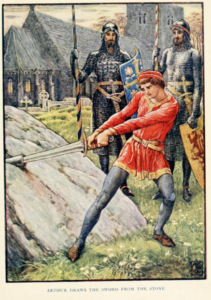


 Ring out, wild bells, to the wild sky,
Ring out, wild bells, to the wild sky,




